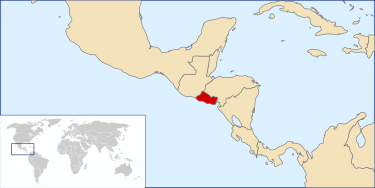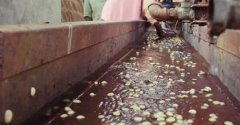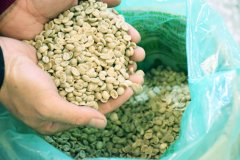Flavor characteristics of Salvadoran Coffee the planting situation of Salvadoran Coffee and the meaning of HIU Plan

For professional baristas, please follow the coffee workshop (Wechat official account cafe_style)
Among the countries of origin in Central America, El Salvador can be said to be the smallest country in land area, although coffee production is much less than other countries, but the Pacific sea breeze and volcanic environment provide El Salvador coffee farmers with unique planting advantages and diversified flavor performance. Among the producing areas of El Salvador, the Santa Ana volcano, which is located 2381 meters above sea level west of the capital, has the advantage of soil quality and planting height. The still active Santa Ana volcano erupted in 2005.
Although it caused heavy economic losses and some casualties to local coffee farmers in that year, the volcanic ash with organic matter later provided a very rich source of nutrients for the local soil, and Santa Ana is still recognized as one of the best producing areas in El Salvador.
About the HIU project:
HIU, a development project to improve the quality of coffee on small farms, has produced more than 500 special micro-batches of coffee in El Salvador and Panama. The sponsor Graciano Cruz has established this operation model based on years of experience in coffee production, working with farmers, producers and exporters, starting from the native regions, with the goal of creating high quality (cup test scores of at least 85 points). Even more demanding) each product is tailored to meet the needs of consumers.
HIU first identified unique products and producers according to varieties, local micro-climate, folk customs, culture or handling methods, confirmed the nature of raw beans through cup testing, and established flavor files.
Before the cooperation begins, let the producers understand the purpose and specification of the HIU program, and jointly construct a plan to improve the quality and yield; in the process, by educating farmers, testing the sugar content of mature coffee cherries, implementing eco-friendly treatments, and constructing equipment to improve the dry environment. And so on, to improve production technology. HIU plans to establish a complete production chain to make each batch identifiable and traceable: establish quality and batch grading with cup tests, special packaging in 50lb (vacuum back box) or 100lb (GrainPro inner bag), maintain traceability of each batch, and provide roaster coffee flavor files and producer information.
□ producing area: Santa Ana Volcano
□ Manor: cloud Manor
□ altitude: 1550m
□ variety: Pacas (pacas)
□ treatment: washing
□ level: SHG
Salvadoran coffee fruits are harvested only once a year, mostly from November to February of the following year. More than 60% of the varieties are bourbon strains. In particular, El Salvador is the main country growing Pacas and Pacamara. In addition, the coffee grading system in El Salvador is basically divided into three grades according to the altitude of planting: lowland C.S. (500murm 900m), highland H.G. (900m Mel 1200m), extremely highland S.H.G. (1200m Mel -).
At present, it is used to drop beans after the end of a dense explosion.
Acid value clean bright chocolate
The sweetness of nuts
Important Notice :
前街咖啡 FrontStreet Coffee has moved to new addredd:
FrontStreet Coffee Address: 315,Donghua East Road,GuangZhou
Tel:020 38364473
- Prev

Buf Cafe small Farm in Rwanda details the description of the flavor of washed red bourbon
Professional barista exchanges please follow the coffee workshop (Wechat official account cafe_style) Rwanda Red Bourbon-Buf Caf small Farm Rwanda is located in the heart of the interior of Africa, its mountain terrain is fertile land, as well as ancient traditional bourbon species, indicating that the natural environment needed to grow quality coffee beans can be found everywhere in Rwanda. Coffee was introduced by German missionaries to Luwang in 1904.
- Next

El Salvador coffee beans taste El Salvador Coffee Manor-Concordia Manor Harmony Farm
For the exchange of professional baristas, please follow the coffee workshop (Wechat official account cafe_style) El Salvador: Concordia Manor Sun Bean La Concordia H.I.U I mentioned earlier that Salvadoran coffee has always been one of my personal favorite coffee producing countries, and I have always liked the beans of Finca La Companula Estate very much, except him.
Related
- Detailed explanation of Jadeite planting Land in Panamanian Jadeite Manor introduction to the grading system of Jadeite competitive bidding, Red bid, Green bid and Rose Summer
- Story of Coffee planting in Brenka region of Costa Rica Stonehenge Manor anaerobic heavy honey treatment of flavor mouth
- What's on the barrel of Blue Mountain Coffee beans?
- Can American coffee also pull flowers? How to use hot American style to pull out a good-looking pattern?
- Can you make a cold extract with coffee beans? What is the right proportion for cold-extracted coffee formula?
- Indonesian PWN Gold Mandrine Coffee Origin Features Flavor How to Chong? Mandolin coffee is American.
- A brief introduction to the flavor characteristics of Brazilian yellow bourbon coffee beans
- What is the effect of different water quality on the flavor of cold-extracted coffee? What kind of water is best for brewing coffee?
- Why do you think of Rose Summer whenever you mention Panamanian coffee?
- Introduction to the characteristics of authentic blue mountain coffee bean producing areas? What is the CIB Coffee Authority in Jamaica?

